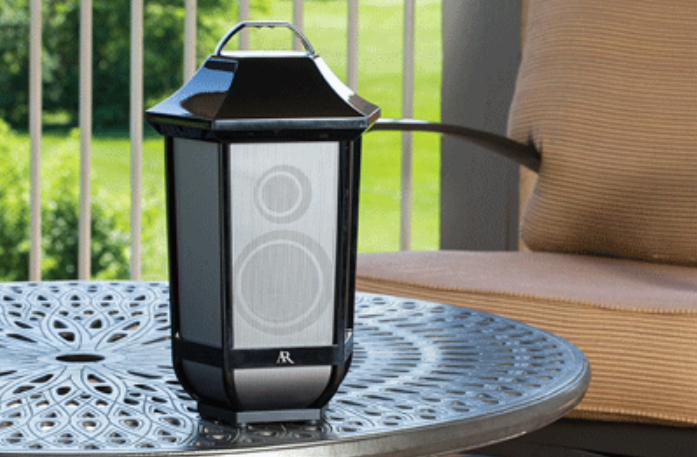
AR Speakers AWS5 Wireless Indoor-Outdoor Speaker
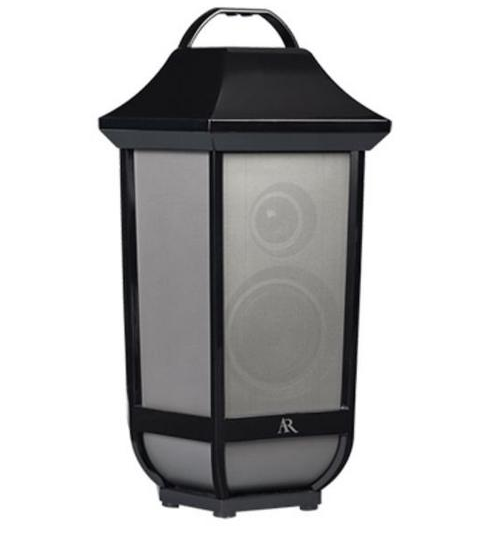
Important Information
Important Safety Instructions
- Read these instructions.
- Keep these instructions.
- Heed all warnings.
- Follow all instructions.
- Clean only with a dry cloth.
- Do not block any ventilation openings. Install in accordance with the manufacturer’s instructions.
- Do not install near any heat sources such as radiators, heat registers, stoves, or other apparatus (including amplifiers) that produce heat.
- Protect the power cord from being walked on or pinched, particularly at plugs, convenience receptacles, and the point where they exit from the apparatus.
- Unplug this apparatus during lightning storms or when unused for long periods of time.
- Refer all servicing to qualified service personnel. Servicing is required when the apparatus has been damaged in any way, such as power-supply cord or plug is damaged, liquid has been spilled or objects have fallen into the apparatus, the apparatus has been exposed to rain or moisture, does not operate normally, or has been dropped.
Care and Maintenance
- Always use a soft cloth to clean the speaker and transmitter. Never use any product containing alcohol or other solvents, as they may damage the surface.
- Use caution when plugging the power transformers into an AC outlet to avoid the risk of electric shock.
- If the speakers are used outside on a deck or patio, make sure you take them indoors in the event of a rainstorm to prevent possible damage.
- Do not operate or store the system in extreme temperatures (below 32°F/0oC and above 122°F/50oC).
Tour of the Speaker System
Speaker
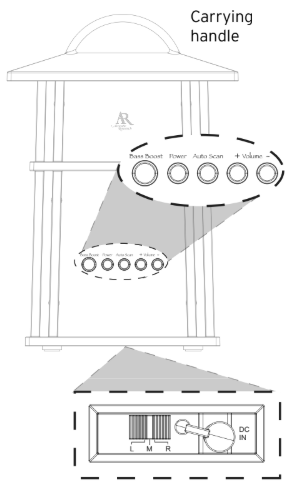
Front Panel
POWER/LINKED indicator (not shown) blinks when the speaker is first powered on; it turns solid blue when the speaker is tuned to the transmitter
Rear Panel: The Bass Boost button turns the speaker’s bass enhancement on and off
The power button turns the speaker on and off
Auto Scan button rescans for the transmitter’s signal
Volume +/– buttons adjust the volume level
Bottom Panel: The L/M/R switch determines if the speaker plays sound in mono as a stand-alone speaker, or plays the left or right track in a stereo pair with an additional AWS5 DC IN receives the small round end of one of the included 9V 1200mA AC power adapters; remove the protective cover to insert the adapter Battery Compartment Cover (not shown) remove to install 6 AA batteries.
Transmitter
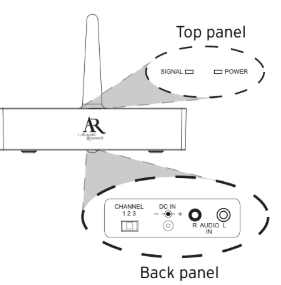
SIGNAL indicator lights green when the audio is present and the transmitter is broadcasting
The POWER indicator lights when the transmitter is on
CHANNEL 1 2 3 lets you find the best transmission frequency for your environment
DC IN jack receives the small round end of the included 12V 200mA AC power adapter.
AUDIO IN (R / L) connects to your sound source using one of the connection options shown here.
Included Accessories

3.5mm to RCA cable
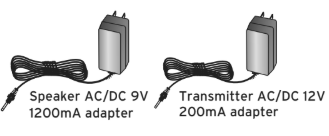
Connecting the Speaker System
Powering the Transmitter
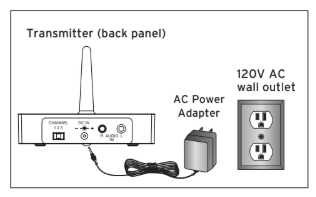
Connect the small, round plug from the transmitter AC power adapter to the transmitter’s DC IN jack. Plug the other end of the transmitter AC power adapter into any standard 120V AC wall outlet.
Connecting to an Audio Source
Connecting to an MP3 player, CD player, or computer
- Plug the stereo plugs into the provided Y-adapter audio cable into the AUDIO IN jacks on the back of the transmitter (make sure to match the colors on the plugs and jacks).
- Plug the mini-plug end of the provided Y-adapter into the headphone output of your MP3 player or CD player (or audio output jack on your computer).
Connecting to an A/V Receiver
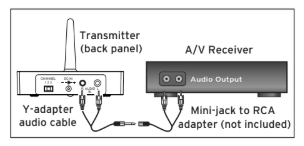
- Plug the stereo plugs into the provided Y-adapter audio cable into the AUDIO IN jacks on the back of the transmitter (make sure to match the colors on the plugs and jacks).
- Plug the mini-plug end of the provided Y-adapter into a mini-jack to RCA adapter (not included).
- Connect the stereo plugs on the mini-jack to the RCA adapter to the corresponding left and right audio outputs of your A/V receiver, amp, or other audio source.
Powering the Speaker
There are two options to power your wireless speaker: using the included AC power adapter or using 6 AA batteries (not included).
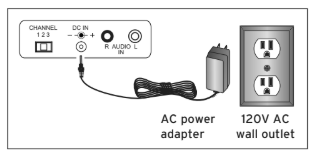
AC Power Adapters
- Insert the small, round plug from the speaker AC power adapter into the DC IN jack on the bottom of the speaker.
- Plug the other end of the speaker’s AC power adapter into any standard 120V AC wall outlet.
AA Batteries
- Remove the battery compartment cover on the bottom of the speaker.
- Insert six (6) AA batteries (not included) into the speaker following the polarity (”+” and “-”) as diagrammed inside the battery compartment.
- Replace the battery compartment cover on the bottom of the speaker.
Pairing the Speaker System
Adjusting the Transmitter
- Turn on your audio source (for example, A/V receiver, MP3 player, stereo, etc.) and play music at a normal listening volume.
- Set the channel select switch on the back of the transmitter to one of the transmitter’s three broadcast frequencies: 1, 2, or 3. If you experience poor reception or interference, try choosing a different frequency by moving the channel select switch to another position.
Tuning the Speaker
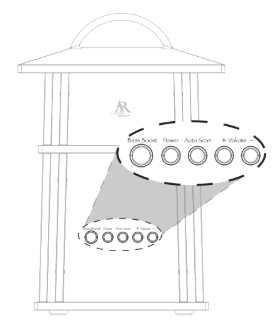
- Press the Power button on the back of the speaker to turn it on. The indicator light on the front of the speaker blinks while the speaker is tuning to the transmitter. The indicator light turns solid blue when the speaker is tuned to the transmitter—you should hear sound coming from the speaker now.
- Adjust the volume on the speaker as desired.
- Set up the speaker for mono or stereo operation using the switch on the bottom of the AWS5 speaker.
- a) Monaural operation: The monaural mode (mono) is recommended when using a single AWS5 by itself. For monaural operation, set the L/M/R switch to “M” on each speaker.
- b) Stereo operation: You need an additional AWS5 speaker for the stereo option. Set the L/M/R switch to “L” on the speaker located to the left of the listener, and set the other speaker to the “R” position.
More Helpful Information
About Fixed-Level Audio Outputs
A fixed-level, or line-level, audio output is considered ideal since it provides an audio signal unchanged by adjustments to the audio source volume control. Fixed-level outputs from TVs are usually marked as ‘Constant,’ ‘Fixed,’ or ‘Select.’ If they are not
marked as such, they are probably variable outputs (see “About Variable-Level Audio Outputs” on the next page). Outputs from DVD players are almost always fixed.
About Variable-Level Audio Outputs:
A variable-level output, such as a headphone jack or certain RCA-type outputs, provides an audio signal that changes with the volume level set on the audio source. As the volume of the audio source is adjusted up and down, so is the audio signal strength sent to the transmitter. This can affect the quality of sound generated by the speaker and may require an adjustment of the volume level of the audio source to produce a signal strong enough for the transmitter.
Troubleshooting
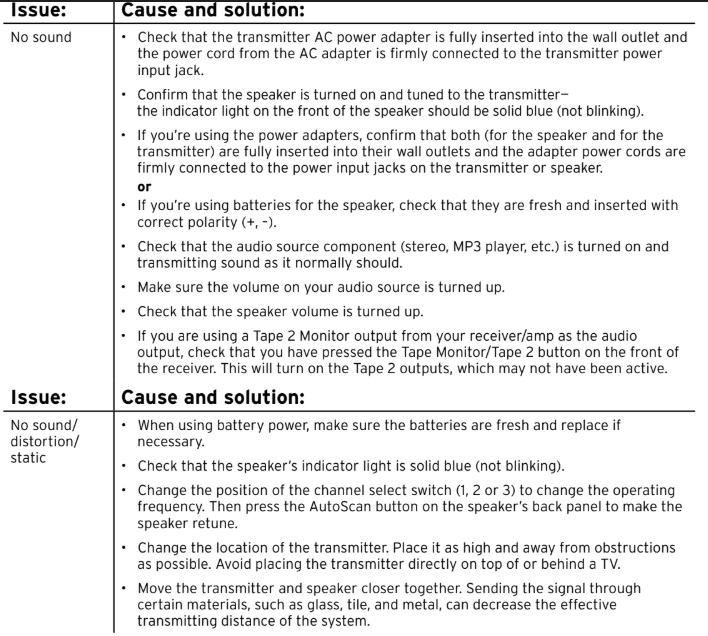
Specifications
Transmitter
- Omni-directional 900MHz broadcast
- Effective transmitting range: up to 150 ft. (45m)*
- Phase-locked loop circuitry (PLL)
- Automatic level control (ALC)
- 3 selectable broadcast frequencies
- Stereo audio input
Speaker
- Push-button, auto-lock tuning
- 2-way acoustic design: 2” tweeter, 3.5” woofer
- 5 Watt RMS internal amplifier
- Omni-directional sound
- Frequency response: 40Hz – 15kHz
- Left/Mono/Right switch
- Operates using supplied AC adapter or six (6) AA batteries (not included).
FOR MORE MANUALS BY Acoustic Research, VISIT MANUALSLIBRARYY
AR Speakers AWS5 Wireless Indoor-Outdoor Speaker-FAQs
Q1. How do AR wireless speakers work?
They connect to your device via Bluetooth or Wi-Fi, receiving signals wirelessly while still needing a power source or built-in battery.
Q2. How do I connect my AR speaker?
Press and hold the Pair button until you hear an audio signal, then select AR Stereo from your device’s Bluetooth menu.
Q3. Do wireless speakers need charging?
Yes. If not plugged into an outlet, AR wireless speakers use rechargeable batteries that need to be recharged periodically.
Q4. Can I use AR speakers without internet?
Yes. They can connect directly to your phone or device using Bluetooth without needing Wi-Fi or internet.
Q5. How do I charge my AR speaker?
Open the rubber cover on the back, plug the USB cable into the DC IN jack, and connect it to a USB power source.
Q6. How far is the Bluetooth range?
Most AR wireless speakers have a Bluetooth range of about 30 feet, depending on obstacles and signal interference.
Q7. What should I do if my speaker won’t charge?
Check the charging cable and port, try a different power source, clean the charging port, or reset the speaker.
Q8. Can I use the AR speaker while charging?
Yes, but it’s recommended to keep the volume low to avoid draining the battery faster.

